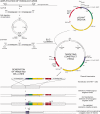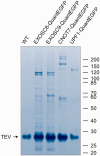A new strategy for gene targeting and functional proteomics using the DT40 cell line
- PMID: 23892402
- PMCID: PMC3783193
- DOI: 10.1093/nar/gkt650
A new strategy for gene targeting and functional proteomics using the DT40 cell line
Abstract
DT40 cells derived from chicken B lymphocytes exhibit exceptionally high homologous recombination rates. Therefore, they can be used as a convenient tool and model for gene targeting experiments. However, lack of efficient cloning strategies, protein purification protocols and a well annotated protein database limits the utility of these cells for proteomic studies. Here we describe a fast and inexpensive experimental pipeline for protein localization, quantification and mass spectrometry-based interaction studies using DT40 cells. Our newly designed set of pQuant vectors and a sequence- and ligation-independent cloning (SLIC) strategy allow for simple and efficient generation of gene targeting constructs, facilitating homologous-recombination-based protein tagging on a multi-gene scale. We also report proof of principle results using the key proteins involved in RNA decay, namely EXOSC8, EXOSC9, CNOT7 and UPF1.
Figures






Similar articles
-
CRISPR/Cas9-mediated generic protein tagging in mammalian cells.Methods. 2019 Jul 15;164-165:59-66. doi: 10.1016/j.ymeth.2019.02.018. Epub 2019 Feb 22. Methods. 2019. PMID: 30797903
-
Development of a targeted flip-in system in avian DT40 cells.PLoS One. 2015 Mar 23;10(3):e0122006. doi: 10.1371/journal.pone.0122006. eCollection 2015. PLoS One. 2015. PMID: 25799417 Free PMC article.
-
Establishment of the DNA repair-defective mutants in DT40 cells.Methods Mol Biol. 2012;920:39-49. doi: 10.1007/978-1-61779-998-3_4. Methods Mol Biol. 2012. PMID: 22941595
-
Reverse genetic studies of homologous DNA recombination using the chicken B-lymphocyte line, DT40.Philos Trans R Soc Lond B Biol Sci. 2001 Jan 29;356(1405):111-7. doi: 10.1098/rstb.2000.0755. Philos Trans R Soc Lond B Biol Sci. 2001. PMID: 11205323 Free PMC article. Review.
-
Dt40 gene disruptions: a how-to for the design and the construction of targeting vectors.Subcell Biochem. 2006;40:1-9. doi: 10.1007/978-1-4020-4896-8_1. Subcell Biochem. 2006. PMID: 17623896 Review.
Cited by
-
Similar but Not Identical-Binding Properties of LSU (Response to Low Sulfur) Proteins From Arabidopsis thaliana.Front Plant Sci. 2020 Aug 14;11:1246. doi: 10.3389/fpls.2020.01246. eCollection 2020. Front Plant Sci. 2020. PMID: 32922422 Free PMC article.
-
Global analysis of S-nitrosylation sites in the wild type (APP) transgenic mouse brain-clues for synaptic pathology.Mol Cell Proteomics. 2014 Sep;13(9):2288-305. doi: 10.1074/mcp.M113.036079. Epub 2014 Jun 3. Mol Cell Proteomics. 2014. PMID: 24895380 Free PMC article.
-
Linear mtDNA fragments and unusual mtDNA rearrangements associated with pathological deficiency of MGME1 exonuclease.Hum Mol Genet. 2014 Dec 1;23(23):6147-62. doi: 10.1093/hmg/ddu336. Epub 2014 Jun 30. Hum Mol Genet. 2014. PMID: 24986917 Free PMC article.
-
Two-step mechanism of J-domain action in driving Hsp70 function.PLoS Comput Biol. 2020 Jun 1;16(6):e1007913. doi: 10.1371/journal.pcbi.1007913. eCollection 2020 Jun. PLoS Comput Biol. 2020. PMID: 32479549 Free PMC article.
-
Effects of Graphene Oxide Nanofilm and Chicken Embryo Muscle Extract on Muscle Progenitor Cell Differentiation and Contraction.Molecules. 2020 Apr 23;25(8):1991. doi: 10.3390/molecules25081991. Molecules. 2020. PMID: 32340398 Free PMC article.
References
-
- Gavin AC, Bosche M, Krause R, Grandi P, Marzioch M, Bauer A, Schultz J, Rick JM, Michon AM, Cruciat CM, et al. Functional organization of the yeast proteome by systematic analysis of protein complexes. Nature. 2002;415:141–147. - PubMed
-
- Ho Y, Gruhler A, Heilbut A, Bader GD, Moore L, Adams SL, Millar A, Taylor P, Bennett K, Boutilier K, et al. Systematic identification of protein complexes in Saccharomyces cerevisiae by mass spectrometry. Nature. 2002;415:180–183. - PubMed
-
- Gavin AC, Aloy P, Grandi P, Krause R, Boesche M, Marzioch M, Rau C, Jensen LJ, Bastuck S, Dumpelfeld B, et al. Proteome survey reveals modularity of the yeast cell machinery. Nature. 2006;440:631–636. - PubMed
-
- Huh WK, Falvo JV, Gerke LC, Carroll AS, Howson RW, Weissman JS, O'Shea EK. Global analysis of protein localization in budding yeast. Nature. 2003;425:686–691. - PubMed
-
- Krogan NJ, Cagney G, Yu H, Zhong G, Guo X, Ignatchenko A, Li J, Pu S, Datta N, Tikuisis AP, et al. Global landscape of protein complexes in the yeast Saccharomyces cerevisiae. Nature. 2006;440:637–643. - PubMed
Publication types
MeSH terms
Substances
LinkOut - more resources
Full Text Sources
Other Literature Sources
Research Materials

